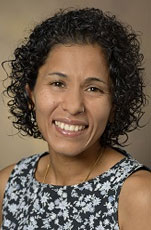UA Researchers Study Link Between Menstrual Cycle and Quitting Smoking
Emerging research has shown that a woman’s menstrual cycle may play an integral role in smoking-cessation outcomes.
Researchers at the University of Arizona Mel and Enid Zuckerman College of Public Health and the Department of Family and Community Medicine at the UA College of Medicine – Tucson will conduct a study to explore how the timing of a quit date during the menstrual cycle may improve smoking-cessation rates among women using a combination of telephone-based behavioral counseling and nicotine-replacement therapy.
The study is funded by a $347,000 two-year grant from the National Institutes of Health, National Institute on Drug Abuse.
The researchers will enroll 116 women between 18-40 years of age from the Arizona Smokers’ Helpline (ASHLine), a free phone and online resource, or “quitline”, which has been helping Arizonans quit smoking and using tobacco since 1995.

Uma Nair, PhD
“Essentially, we are taking the quitline model and tailoring it to the specific needs of premenopausal women,” said Uma Nair, PhD, assistant professor of health promotion sciences at the UA Zuckerman College of Public Health and assistant director of ASHLine.
Dr. Nair is co-principal investigator of the study and a cancer and tobacco control researcher with a focus on low-income and at-risk vulnerable populations. Her past research includes postpartum depression in smokers, the effects of second-hand smoke in infants and toddlers and the use of physical activity to help people quit smoking.
The women will receive four weeks of nicotine-replacement therapy (NRT) in the form of a patch, which can help relieve some of the physical withdrawal symptoms without the other harmful chemicals in tobacco, and six-weeks of telephone-based behavioral counseling. The women also will track their menstrual cycle while they are in the study and be compensated for their time and efforts.
”We know that craving and withdrawal can vary across the menstrual cycle, but we don’t yet know if targeting a specific menstrual cycle phase to quit smoking will help women quit,” said Alicia Allen, PhD, MPH, assistant professor in the UA Department of Family and Community Medicine and co-principal investigator of the study.

Alicia Allen, PhD, MPH
Dr. Allen, a behavioral epidemiologist who researches addictive behaviors in women, explained that compared to men, women are more likely to experience smoking-related illness and death. Women also are the primary source of secondhand smoke exposure for children.
Dr. Nair said that quitlines like ASHLine have become standard care for smoking cessation. Every state in the nation has a quitline.
“Quitlines are highly successful, broad-reaching and cost-effective programs that disseminate smoking-cessation treatment. Yet little research has explored how to optimize and individualize quitline services for women,” Dr. Nair added.
“The results of this study will directly inform future research on quitline smoking-cessation interventions for women of reproductive age, including a full-scale clinical trial. If successful, this model can be cost-effectively replicated within quitlines nationally,” Dr. Nair added.
The Arizona Smokers’ Helpline, which is located within the UA Mel and Enid Zuckerman College of Public Health, is funded by the state tax on tobacco products. For more information about the study, please contact Dr. Nair and Dr. Allen at ProjectPhase@email.arizona.edu.
The project is funded by the National Institutes of Health, National Institute on Drug Abuse, grant No.: 1R21DA046604-01.

